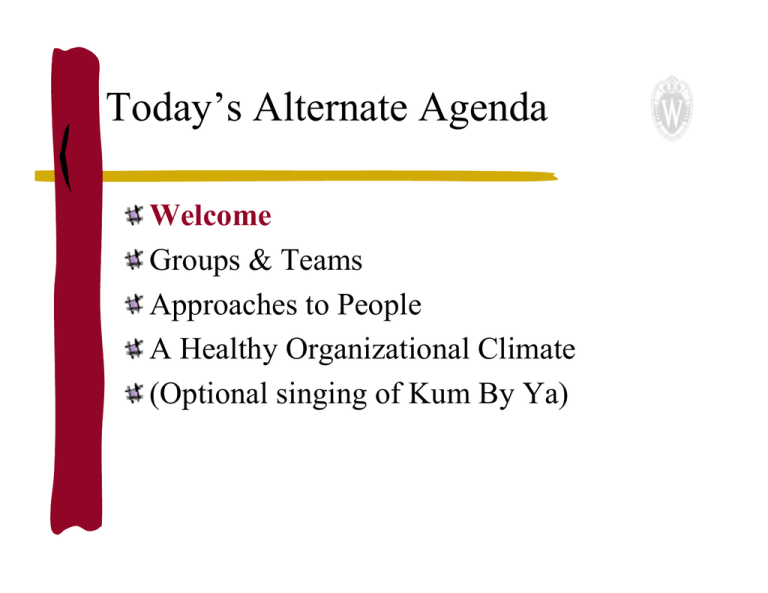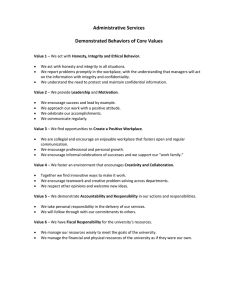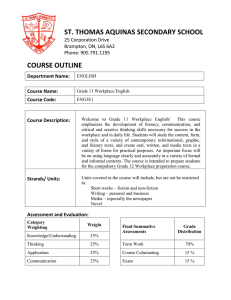Today’s Alternate Agenda
advertisement

Today’s Alternate Agenda Welcome Groups & Teams Approaches to People A Healthy Organizational Climate (Optional singing of Kum By Ya) Themes Mission and leadership are critical The way you treat other people matters Simple strategies can have a great impact Decisions occur with or without action Where This is Leading… There must be a fundamental commitment to creating a workplace where people are respected, individual contributions are valued, and the purpose of the work is for the good of the organization. These conditions, supported by intentional planning and behaviors consistent with the commitment, results in a highly productive and satisfying environment. Basic Needs of People in Groups Sense of Belonging Share in planning group goal Goals that are within reach Participation contributes to human welfare Know what is expected Challenging responsibilities See progress Kept informed Confidence in the leader Situation must make sense Group Development (Tuckman) 1. Forming Members uncertain about roles, rules, & expectations 2. Storming Conflict over goals and personalities 3. Norming Working styles are agreed and systems set up 4. Performing Team works creatively and productively 5. [Adjourning] Tuckman, 1965 Thoughtful Moment… One [person] alone can be pretty dumb sometimes, but for real bona fide stupidity, there ain't nothin' can beat teamwork. - Edward Abbey, Environmentalist Teamwork “A set of values that encourage listening and responding constructively to views expressed by other, giving others the benefit of the doubt, providing support, and recognizing the interests and achievements of others” Katzenbach & Smith, 2005 Team Building The process of enabling groups to reach their goals Occurs over time and is rooted in people’s experiences in the workplace Is created through intentional and thoughtful care and nurturing Produces an engaged and productive workforce Team Building Characteristics Developing relationships Communicating effectively Naming decisions (Transparency) Understanding power Engaging others Importance of Roles • Role • • A set of expectations held by the individual and relevant others about how that individual should act in a given situation Defined by specific tasks she or he is expected to perform • Role Clarity • Absence of two stressful conditions: role ambiguity and role conflict Role Ambiguity • Individual does not have enough information about • • • what she or he should be doing what are appropriate ways of interacting with others what are appropriate behaviors and attitudes • Particularly new employees • Also new managers making the transition from worker to manager because of changing expectations Role Conflict • Individual perceives information regarding her or his job to be inconsistent or contradictory • Potential sources when one or more individuals with whom an employee interacts sends conflicting messages about what is expected • when an individual plays multiple roles that have conflicting expectations • individual’s own morals and values conflict with the organization’s mission or policies • When expectations for a given role exceed the available time to complete those tasks • Informal Approaches Work to establish trust in work environment influenced by our observations of others create an atmosphere where it is safe to trust others consider group interactions to create opportunities for people to get to know each other Don’t confuse “liking” with “trusting” Formal Approaches b Important sometimes to stop the action b Formal activities allow teams to b b b b put aside the work of the day evaluate how well the group is performing make any necessary changes focus on information exchange to increase communication Rules Leaders cannot make physical contact with participants or the materials Participants cannot look back or get out of the chair Observers cannot comment or make suggestions Safety first… if you feel your chair tipping over, make an adjustment Group Process Questions The first time we did this: What was the leader’s role? Responsibilities? Did the leader get positive results? What were the main problems? How did it feel? The second time: What was the leader’s role? Responsibilities? What the role/main activities of each participant? Individual Process Questions for Leaders 1. What can we do so that the vision is clear? 2. How can you make sure that staff have the necessary materials & equipment? 3. How can you make sure that staff receive the necessary training? 4. How can you motivate people to achieve goals? 5. How can you remove big obstacles? McGregor: Theory X = People dislike working and will try to avoid it if they can = people need to be coerced or controlled by management = average employees want to be directed = people don’t like responsibility = need authoritarian managers McGregor, 1960 McGregor: Theory Y = People view work as an important part of life = people are motivated to find meaning in life and work = job satisfaction engages employees = people learn to accept and will seek responsibility = need participative managers McGregor, 1960 Workplace Engagement Please complete the questionnaire Product of two mammoth Gallup research studies Over the last 25 years Surveyed over a million employees Asked “What do the most talented employees need from their workplace?” Workplaces that would attract and retain the most productive employees and scare away the ROAD warriors Buckingham & Coffman, 1999 Finding “The manager – not pay, benefits, perks or a charismatic corporate leader – was the critical player in building a strong workplace” Four business outcomes: productivity, profit, retention & customer service Twelve questions with four different stages Looking for “Employee Engagement” Buckingham & Coffman, 1999 Four Stages What do I get? 1. 2. Do I know what is expected of me at work? Do I have the materials and equipment to do my work right? What do I give? 3. 4. 5. 6. At work, do I have the opportunity to do what I do best every day? In the last seven days, have I received recognition or praise for doing good work? Does my supervisor, or someone at work, seem to care about me as a person? Is there someone at work who encourages my development? Buckingham & Coffman, 1999 Four Stages Continued Do I belong here? 7. At work, do my opinions seem to count? 8. Does the mission/purpose of my company make me feel my job is important 9. Are my co-workers committed to doing quality work 10. Do I have a best friend at work? How can we all grow? 11. In the last six months, has someone at worked talked to me about my progress 12. This last year, have I had opportunities to work to learn and grow? Buckingham & Coffman, 1999 A Strong & Vibrant Workplace 1. Do I know what is expected of me at work? 2. Do I have the materials and equipment to do my work right? 3. At work, do I have the opportunity to do what I do best every day? 4. In the last seven days, have I received recognition or praise for doing good work? 5. Does my supervisor, or someone at work, seem to care about me as a person? 6. Is there someone at work who encourages my development? Most powerful questions – strongest links to productivity, profit, retention & customer service Buckingham & Coffman, 1999 Retention-related Questions 1. Do I know what is expected of me at work? 2. Do I have the materials and equipment to do my work right? 3. At work, do I have the opportunity to do what I do best every day? 5. Does my supervisor, or someone at work, seem to care about me as a person? 7. At work, do my opinions seem to count? Buckingham & Coffman, 1999 Climate Behaviors within a workplace or learning environment, ranging from subtle to cumulative to dramatic, that can influence whether an individual feels personally safe, listened to, valued, and treated fairly and with respect. What Do We Mean by Climate? Prevailing atmosphere of civility and mutual respect Measured by how it “feels” to people who work and learn here Created by day-to-day behaviors of everyone OHRD Principles of Practice Principles of Practice The Office of Human Resource Development at UW-Madison strives to advance these principles in our daily interactions with others. Principle 1: Community through Respect & Civility It is critical to promote respect and the practice of civility in the workplace community. Principle 2: Excellence through Diversity Diversity of gender, ethnicity, disability, religion, sexual orientation, culture, position, job function, and years of service are crucial components in the pursuit of excellence. Principle 3: Success through Learning Continuous professional development is vital to individual and organizational success. In Position Descriptions B. Commitment to Respect & Success B1. Promote respect and the practice of civility in the workplace. B2. Demonstrate a commitment to organizational success. Focus Question “What values, beliefs, principles do we share in this department/office about: 1) the work we do, 2) how we conduct business, 3) how we treat each other, and 4)how we treat those we serve?” Themes Team building is a process not an incident The way you treat other people matters Simple strategies can have a great impact Decisions occur with or without action Collaborative Organizations Mission Degree to which you know why you exist and the direction you are going Involvement Degree to which you are engaged in and hold the mission as your own Adaptability Degree to which can respond to learning about and respond to external demands Consistency Systems and processes support efficiency and effectiveness A Productive & Satisfying Workplace A fundamental commitment to creating a workplace where people are respected, individual contributions are valued, and the purpose of the work is for the good of the organization. Support through intentional planning and demonstrating behaviors consistent with the commitment Final Thoughtful Moment… We don't accomplish anything in this world alone ... and whatever happens is the result of the whole tapestry of one's life and all the weavings of individual threads from one to another that creates something. - Sandra Day O’Connor References Bloch, P. (2000). Flawless Consulting:A guide to gettting your expertise used. NY: Jossey-Bass/Pfeiffer Buckingham, M., & Coffman, C. (1999). First, Break All the Rules: What the World’s Greatest Managers Do Differently. NY: Simon & Schuster. Ertel, D. (November 2004). Getting past yes: Negotiating as if implementation mattered. Harvard Business Review, 82(11), pp. 6068. Katzenbach, J. R., & Smith, D. K. (July-August 2005). The discipline of teams: What makes the difference between a team that performs and one that doesn’t? Harvard Business Review, 83(7), pp. 162-171. McGregor, D. (1960). The Human Side of Enterprise. NY: McGrawHill. Tuckman, Bruce. (1965). Developmental sequence in small groups. Psychological Bulletin, 63, 384-399. Reading List Bohm, David, Factor, Donald & Peter Garrett.(1991). Dialogue—A Proposal. http://www.muc.de/~heuvel/dialogue/. Chabot, Brian. (March, 2002). Characteristics of excellent departments. Academic Leader: A newsletter for academic deans and department chairs. Madison, WI: Magna. Chang, R. Y. (1994). Success Through Teamwork: A Practical Guide to Interpersonal Team Dynamics. Irvine, CA: Richard Chang Associates, Inc. Covey, Steven. (1989) The 7 habits of highly effective people. New York: Simon and Schuster. Heller, R. (1998). Managing Teams. NY: DK Publishing, Inc. Scholtes, P. R. (1998). The Leader’s Handbook: A Guide to Inspiring Your People and Managing the Daily Workflow. NY: McGraw-Hill.



